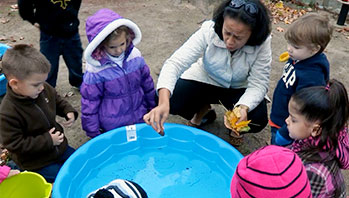- milk cartons (pint)
- marker
- staples and stapler
- craft sticks (mast)
- paper squares (sails)
- clay
- balance
- boat
- float
- sink
MA Standards:
Speaking and Listening/SL.PK.MA.5: Create representations of experiences or stories (e.g., drawings, constructions with blocks or other materials, clay models) and explain them to others.
Language/L.PK.MA.6: Use words and phrases acquired through conversations, listening to books read aloud, activities, and play.
Mathematics/Counting and Cardinality/PK.CC.MA.5: Use comparative language, such as more/less, equal to, to compare and describe collections of objects.
Mathematics/Measurement and Data/PK.MD.MA.2: Compare the attributes of length and weight for two objects, including longer/shorter, same length; heavier/lighter, same weight; holds more/less, holds the same amount.
MA Draft STE Standards:
Earth and Space Sciences/Earth’s Systems/ESS2.A: Observe, investigate, and classify the non-living materials, natural and human made, in their environment.
Head Start Outcomes:
Logic and Reasoning/Reasoning and Problem Solving: Classifies, compares, and contrasts objects, events, and experiences.
Science Knowledge/Scientific Skills and Method: Observes and discusses common properties, differences, and comparisons among objects.
PreK Learning Guidelines:
English Language Arts/Language 2: Participate actively in discussions, listen to the ideas of others, and ask and answer relevant questions.
Science and Technology/Earth and Space Sciences 5: Compare and contrast natural materials such as water, rocks, soil, and living organisms using descriptive language.
Science and Technology/Physical Sciences 19: Explore, describe, and compare the properties of liquids and solids found in children's daily environment.
Explore Together (outdoors): Milk Carton Boats

© Commonwealth of Massachusetts, Department of Early Education and Care. All rights reserved.
STEM Key Concepts: Objects behave differently in water; Some things float; Some things sink; If you add enough weight to a floating object, it will sometimes sink; Solids have physical characteristics that can be observed and described
ELA Focus Skills: Cause and Effect, Compare and Contrast, Follow Directions, Listening and Speaking, Vocabulary
Educator Prep: You will need a half of a pint milk carton for each child. Cut the milk cartons in half lengthwise to make two boat-shapes. Staple the spouts shut. Prepare one for each child and write his or her name or initials on the bottom. Prepare a finished milk carton to have on display for children to reference. (Lay the milk carton down on a table with the hull (open part) facing up; Tape a triangle “sail” to the craft stick “mast;” Place the clay to the inside bottom of the hull, near the middle of the boat; Stick the craft stick mast into the clay so that it stands tall.)
Tell children they are going to build a new boat and continue to explore floating and sinking. Explain that this time children will collect objects outside to explore. Encourage children to find pebbles, leaves, needles, and other things on the ground outside.
Model how to build the milk carton boat, or place one out for children to refer to in making their own. Be available if children have questions or need guidance.
- Once children have finished their boat, have them put it in water to check if it is stable. If it tips over, talk about balance and how they can move the clay to a different place in the boat to balance the boat and allow it to float.
- Help children use cardboard or their breath to blow on the sails and make the boats move.
Have children collect things outdoors to use as weights for exploring or bring out the materials children collected during their plant unit. Allow children to freely explore with their boats. Encourage children to explore balancing their boats by placing objects in their boats. Then have them explore how many objects a boat can hold and still float. Prompt children to work together to explore different materials and discuss why their boats can hold many of some objects, but only a few of others. Circulate and take photos, and be available to give help if needed.
Reflect and Share
Allow plenty of time for children to explore, then gather the group inside and encourage children to share their observations. Ask questions such as:
- Why do you think the milk carton boats could hold heavier things than the aluminum foil boats?
- Did your boat move faster when you blew on it or when you fanned it? Why do you think that is?
- Did you find any objects that were too light to make your boat sink?
- Why do you think you only needed one rock but many toothpicks to make your boat sink?
